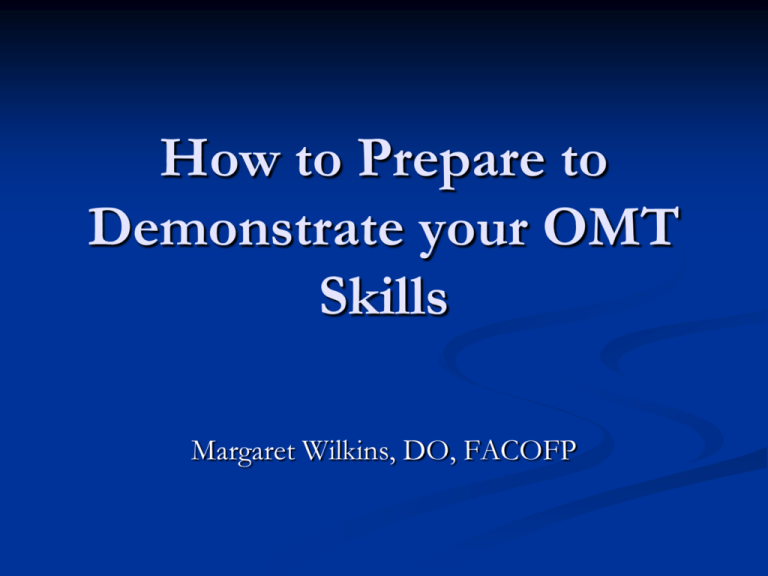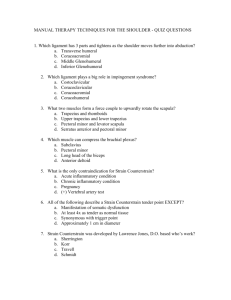OMT Board Review
advertisement

How to Prepare to Demonstrate your OMT Skills Margaret Wilkins, DO, FACOFP Objectives Increase familiarity with osteopathic terminology Provide tips on how to study for the practical section of the Boards Review case scenarios Learning the Lingo Somatic dysfunction – “impairment or altered function of the somatic system: Skeletal Arthroidal Myofascial Vascular Lymphatic Neural Somatic Dysfunction TART Tissue texture changes Asymmetry Restriction Tenderness Tissue Texture Changes Acute changes Chronic changes Erythema Pallor Warmth Cold Moist Dry Boggy / edematous Ropy / fibrotic Contracted muscle Decreased tone Somatic Dysfunction Chapman’s Points Small (2-3mm) Firm/nodular and tender Paired anteriorly and posteriorly Found bilaterally for paired organs Rarely found midline Represent a viscerosomatic reflex Somatic Dysfunction Ganglion Cranial and spinal nerves pass through Parasympathetic and sympathetic Ones we normally treat Celiac Superior mesenteric Inferior mesenteric Treatment Direct vs. Indirect Direct – into the restrictive barrier Used in the chronic situation Used in the outpatient setting Indirect – away from the barrier Used in acute pain Employed in the hospital setting Treatment Passive vs. Active Passive – we do the work Active – patient helps Treatment Muscle energy Direct Active Treatment Counterstrain – recently found to be the most effective long term treatment for pain Indirect Passive Treatment HVLA Direct Passive Preparing to Study Three good books The 5 minute OMM Consult OMT Review By Millicent King Channell and David Mason Paperback, great review of incorporating OMM into FP By Savarese, Capobianco and Cox Paperback, has review questions with explanations COMLEX Review:Clinical Anatomy and OMM By Modi and Shah Paperback, short descriptions Studying Find a partner Practice what you know and use Explain in words as you are performing Format of the Practical Exam There will be 3 testing stations Spine Extremity Family Practice / Viscerosomatic case Studying Demonstrate your structural exam findings, especially key landmarks Prepare 2 techniques per area of SD Soft tissue / MFR Muscle energy HVLA Counterstrain Lymphatic drainage Areas of Somatic Dysfunction Cranial 739.00 Pelvic 739.5 Cervical 739.1 Lower Extremity 739.6 Thoracic 739.2 Upper Extremity 739.7 Lumbar 739.3 Ribs 739.8 Sacral 739.4 Other 739.9 Procedure Codes Treat 1-2 areas – 98925 Treat 3-4 areas – 98926 Treat 5-6 areas – 98927 Treat 7-8 areas – 98928 Treat 9-10 areas - 98929 * 25 Modifier! Cases Neck pain 25 yo male stayed at his in-laws’ house and they gave him the fattest, firmest pillow. Now c/o pain in his right neck with limited ROM. No paresthesias. Structural exam findings? Diagnoses? Techniques? OMT for Cervical SD Soft tissue Counterstrain Muscle Energy Cases Wrist pain 47 yo transcriptionist c/o tingling in her fingers and pain in wrist that radiates to her elbow. Structural exam findings Diagnoses? Treatment Upper Extremity SD Soft tissue Muscle energy HVLA to carpal bones Constipation 5 month old presents with parent with hard, infrequent stools. No blood. Eating OK, in fact, eating lots of rice cereal. Structural exam findings Diagnoses Treatment Viscerosomatic SD Treatment – osteopathic MFR of ganglion Reset autonomics – rib raising Inhibition of Chapman’s points Colonic stimulation Treatment Nutritional strategies Discuss stimulation and medicine concerns Do’s and Don’ts Do Use familiar techniques Jot down your thoughts on the case report Talk out loud as you examine and set up Appear confident! Remember other aspects of medical care: PT, meds, diagnostic studies Don’t Start talking about a technique or term that you can’t bring full circle Tell the examiner that you don’t usually do OMM Ask the examiner to teach you the technique Try to give more info than they are asking for Hurt your partner







